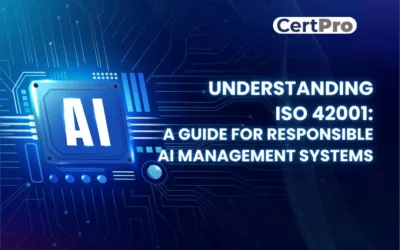ISO 9001:2015
QUALITY MANAGEMENT SYSTEM
ISO 9001 is a globally recognized standard that establishes an effective Quality Management System (QMS). It plays a crucial role in enhancing organizational efficiency and improving customer satisfaction. The core objective of the ISO 9001 standard is to fulfill customer requirements and surpass their expectations, making it increasingly relevant in today’s fast-paced world. Adopting ISO 9001 equips businesses with a powerful tool to enhance resilience, streamline operations, and reduce costs. This standard facilitates business growth and enables companies to adapt to evolving needs, effectively assisting them in achieving their objectives. By implementing ISO 9001, businesses can enhance their quality management systems and gain international recognition, which increases their credibility. ISO 9001 certification is a valuable framework that enables organizations to continuously improve and demonstrate their commitment to delivering high-quality products and services.

Certification and Auditing Services by CertPro for ISO 9001:2015
At CertPro, we recognize the criticality of quality management systems and the value of ISO 9001:2015 certification for organizations aiming to enhance their processes and deliver exceptional products and services. We provide comprehensive assistance to businesses pursuing ISO 9001:2015 certification. Our team of proficient experts will lead you through the certification journey, ensuring that your organization’s quality management practices align with the latest ISO standards. We will work closely with your team to develop and implement an efficient quality management system customized to your unique needs and industry standards.
Why choose CertPro for ISO 9001:2015 certification and auditing?
CertPro stands out as a trusted partner in the realm of ISO 9001:2015 certification and auditing services. With nearly 10 years of expertise in the industry, we have honed our skills and gained valuable insights into the intricacies of Quality management System. Here are some compelling reasons why you should choose CertPro:
| Factors | CertPro Advantage |
|---|---|
| Time to Certification | 4x faster than traditional approaches |
| Price | Competitive rates with flexible options |
| Process | Streamlined and efficient methodology |
| Expertise | 10+ years of industry experience |
CertPro’s Cost-Effective Approach to ISO 9001:2015 Certification
When considering ISO 9001:2015 certification, the total cost can often be overwhelming, encompassing various factors that influence the overall expenses. We offer a tailored pricing structure based on the number of team members and the time required for certification. With our transparent pricing model, you can easily determine the costs associated with your organization’s size. Here’s a breakdown of our pricing tiers:
| No. of employees | Timeline | Cost (approx.) |
| 1 – 25 | 4 weeks | 2500 USD |
| 25-100 | 6 weeks | 4500 USD |
| 100-250 | 8 weeks | 7500 USD |
| 250 plus | 8-12 weeks | Custom plans |
UNDERSTANDING THE QUALITY MANAGEMENT PRINCIPLES
ISO 9001 sets the criteria for a Quality Management System (QMS) undergoing auditing for voluntary compliance or third-party registration. Its requirements are universally applicable to organizations of any size or type. The International Organization for Standardization (ISO) issues a company-level certification based on adherence to the standard “Quality Management System requirements.” The certification incorporates a higher-level structure for all ISO management systems, including risk-based analysis and enhanced leadership requirements. This non-industry-specific certification is for enterprises aiming to establish and maintain a QMS. Regular audits are necessary to maintain ISO 9001:2015 certification and ensure ongoing compliance with the standards.
ISO 9001 assists organizations in ensuring the consistent delivery of high-quality products and services to their customers. It, in turn, yields various benefits, including customer satisfaction, effective management, and motivated employees. The scope statement precisely delineates the organization’s products and services, regulatory requirements, supported activities, remote locations, and facilities. Essentially, the scope statement identifies the specific nature of the business operations supported and documented by the organization’s quality management system, providing a clear understanding of the organization’s core activities.
THE KEY PRINCIPLES OF ISO 9001
There are seven ISO 9001 principles, and an organization will reap the rewards of better customer satisfaction, greater consistency, and stronger performance by following these principles.
Seven principles that constitute a quality management system:
- Customer focus: Placing a strong emphasis on understanding and meeting customer requirements, enhancing customer satisfaction, and building positive relationships.
- Leadership: Promoting leadership in involvement and commitment to the QMS, ensuring a clear direction and objectives, and fostering a culture of continuous improvement.
- Engagement of people: Involving and empowering employees at all levels, recognizing their contributions, and promoting a collaborative and supportive working environment.
- Process approach: Adopting a systematic approach to managing processes and their interactions to achieve desired outcomes.
- Improvement: Promoting a culture of continuous improvement, encouraging innovation, and seeking opportunities to enhance the QMS and organizational performance.
- Evidence-based decision-making: Making informed decisions based on reliable data and information, employing analytical thinking, and evaluating risks and opportunities
- Relationship management: Building and maintaining mutually beneficial relationships with suppliers, partners, and relevant stakeholders to create value and optimize performance.
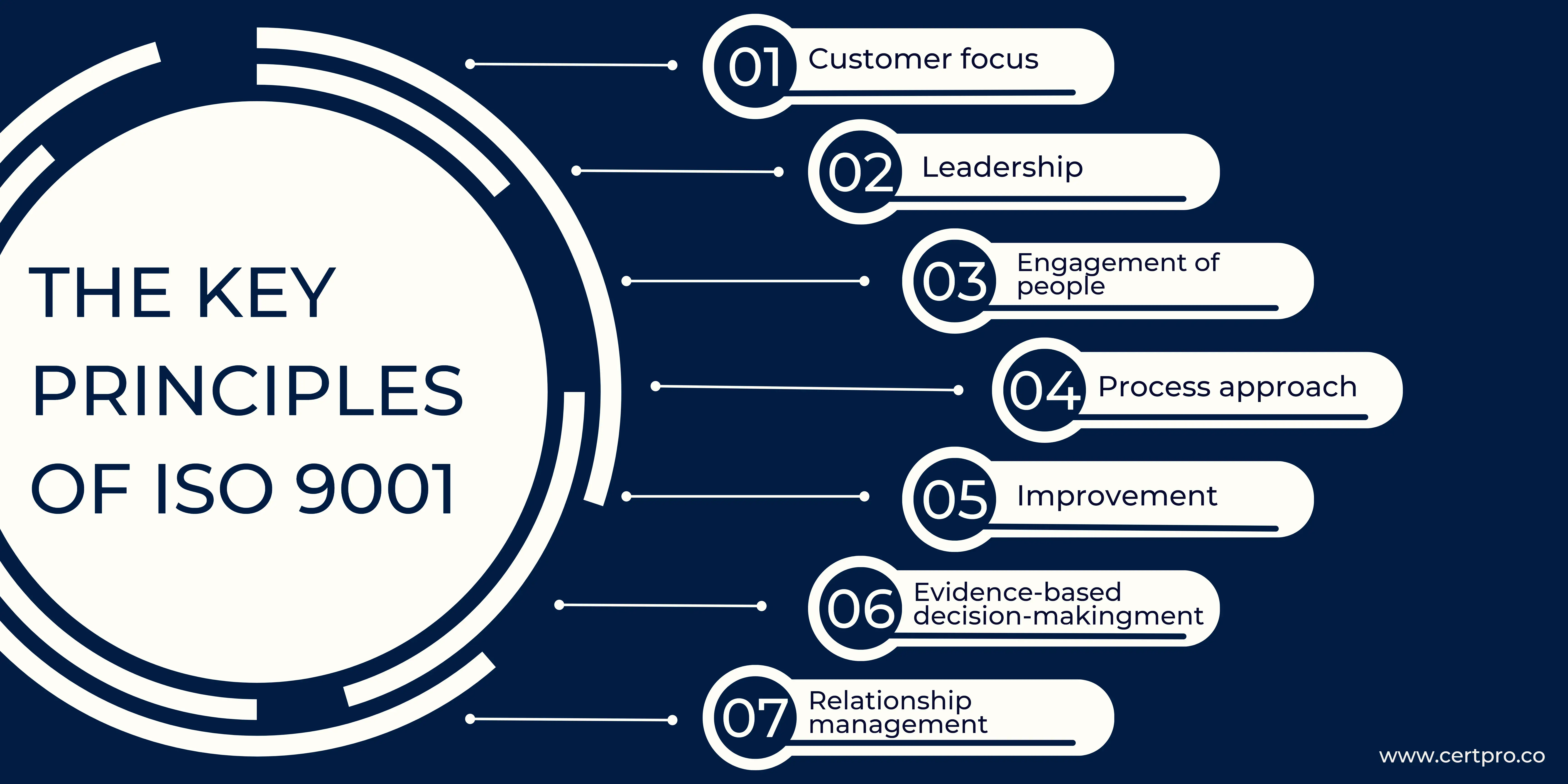
AN ISO 9001 AUDIT
An ISO 9001 audit is essential for achieving and maintaining ISO 9001 certification. It offers several benefits:
- Ensuring Compliance: The audit verifies that your Quality Management System (QMS) adheres to the ISO 9001 standard.
- Addressing Issues: The audit helps identify and resolve any problems within your QMS.
- Discovering Improvements: It assists in identifying potential areas for enhancement within your system.
- Meeting Quality Objectives: The audit ensures that your organization undergoes appropriate action to meet its quality objectives.
The ISO 9001 audit is a systematic, independent, objective, and well-documented process to gather factual information, enabling you to identify improvement areas and establish best practices. Continuous improvement is a fundamental aspect of ISO 9001.
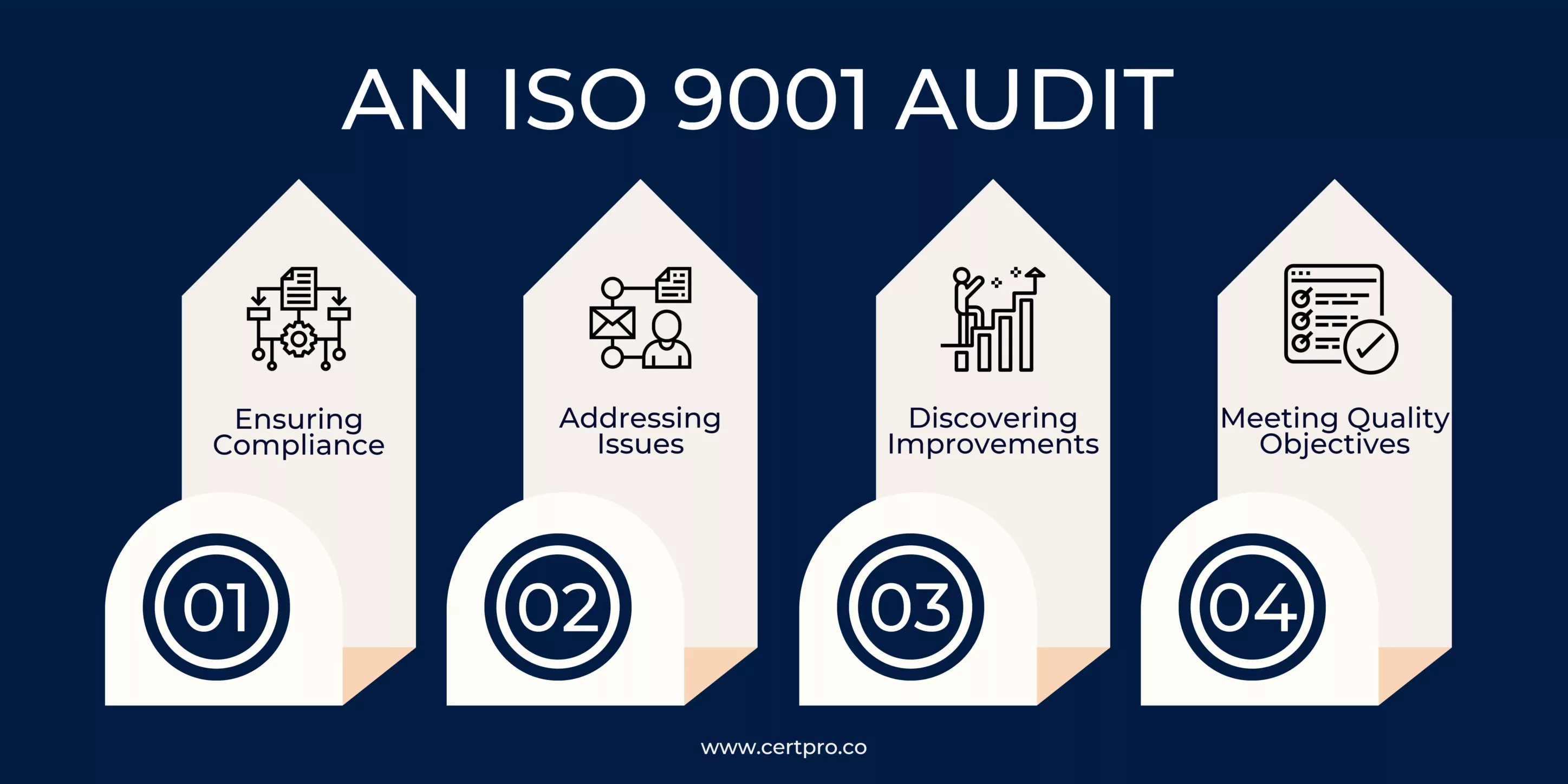
There are two types of audits: internal audits and external audits
ISO 9001 INTERNAL AUDITS:
Internal audits for ISO 9001 should be formal, impartial, objective, and follow established procedures. Auditors use checklists to record evidence and assess process alignment with documented policies and procedures. Internal audits help prepare the organization for external audits. These audits help identify areas for improvement. Observations are recorded and reviewed during management review meetings, which must be conducted quarterly to foster continual improvement.
ISO 9001 EXTERNAL AUDITS:
External audits encompass customer, supplier, certification, and surveillance audits. Customer audits involve existing or potential customers verifying that the organization meets their requirements. Supplier audits assess external provider control. Certification audits by registrars verify conformity to ISO 9001 standards for issuing official certificates. Stage one audits assess readiness, often conducted remotely, while stage two audits evaluate compliance. Registrars conduct surveillance audits periodically. Certification audits occur every three years to ensure ongoing adherence to ISO requirements without certificate issuance. Certification bodies typically perform surveillance audits annually.
An ISO 9001 audit is a comprehensive review process that helps organizations evaluate the effectiveness of their QMS, identify areas for improvement, and ensure ongoing compliance with the ISO 9001 standard. It promotes a culture of quality and continual improvement within the organization.
HOW TO GET ISO 9001 CERTIFICATION
The steps to get ISO 9001 certification are:
1. Understand the ISO 9001 Standard: The first step is to familiarize yourself with the ISO 9001 standard. This internationally recognized quality management system standard sets out the criteria for a quality management system (QMS) and provides guidelines for organizations to meet customer requirements, enhance customer satisfaction, and improve overall performance.
2. Conduct a Gap Analysis: Perform a gap analysis to assess your organization’s current processes, procedures, and practices against the requirements outlined in the ISO 9001 standard. This analysis will help identify areas where your organization complies with the standard and areas that need improvement to meet the requirements.
3. Develop an Implementation Plan: Based on the results of the gap analysis, develop a comprehensive implementation plan. This plan should outline the necessary steps, allocate resources, set timelines, and define responsibilities to ensure a smooth transition to ISO 9001 compliance.
4. Staff Training and Awareness: Ensure all relevant staff members are trained and aware of the ISO 9001 standard and its requirements. It may involve providing training sessions, workshops, or other educational materials to enhance employees’ understanding of quality management principles and their roles within the QMS.
5. Establish QMS Documentation: Develop and implement the necessary documentation for your QMS. It includes quality policies, objectives, procedures, work instructions, and records to ensure the organization’s processes and activities are well documented and aligned with the ISO 9001 standard.
6. Implement the QMS: Roll out and implement the QMS across your organization. It involves the documentation of practices to ensure that employees follow the established procedures and integrate quality management practices into day-to-day operations.
7. Conduct Internal Audits: Perform internal audits to assess the effectiveness of your QMS and identify any non-conformities or areas for improvement. Internal audits help you evaluate your organization’s compliance with the ISO 9001 standard and identify opportunities to enhance your QMS.
8. Pre-Certification Audit: Before the final certification audit, consider conducting a pre-certification audit. Before the certification audit, a pre-certification audit by an internal or external team evaluates the organizational readiness for certification, identifying and addressing any gaps.
9. Certification Audit and Surveillance: Finally, submit to a certification audit by an accredited certification body. The certification audit evaluates your organization’s compliance with the ISO 9001 standard and determines whether you meet the requirements for certification. If successful, your organization will receive ISO 9001 certification. After the certification, regular surveillance audits are conducted to ensure ongoing compliance with the standard.
By following these steps, organizations can work towards achieving ISO 9001 certification and demonstrate their commitment to quality management principles.
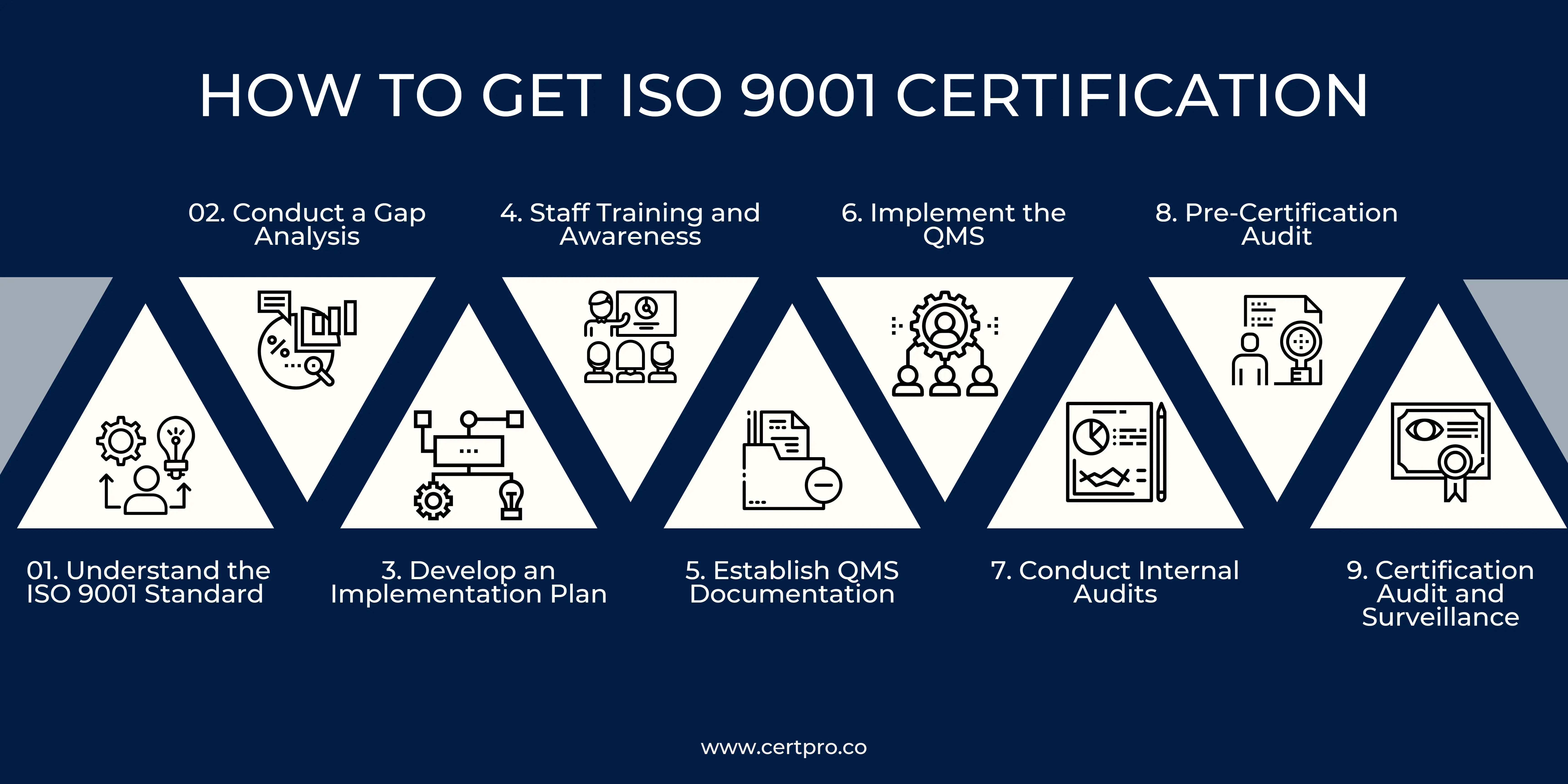
THE REQUIREMENTS OF ISO 9001 CERTIFICATION
The ISO 9001 requirements guide organizations in implementing, maintaining, and improving a Quality Management System (QMS). They encompass standard elements applicable to all types of organizations, regardless of size, sector, or profit orientation. The requirements consist of 10 sections (known as ISO 9001 clauses). Clauses 1 to 3 are optional for implementation, whereas clauses 4 to 10 are mandatory.
- Clauses 1 to 3: Scope, References, and Terms and Definitions: Clauses 1 to 3 do not impose any requirements; instead, they pertain to the scope of the standard, references for better comprehension, and terminologies and definitions used within.
- Clause 4: Context of the Organization: The organization must understand the context in which it operates, including the needs and expectations of interested parties such as customers, employees, suppliers, and regulatory bodies. It helps in defining the scope and objectives of the QMS.
- Clause 5: Leadership: Top management requires leadership and a commitment to the QMS. They should establish a quality policy, assign responsibilities, ensure resources are available, and promote a culture of continuous improvement.
- Clause 6: Planning: Identifying risks and opportunities, setting objectives, and developing plans to achieve them, considering the organization’s context and customer requirements
- Clause 7: Support: Providing necessary resources, establishing competent personnel, ensuring awareness and communication, and maintaining documented information
- Clause 8: Operation: This requirement covers the execution of the processes defined within the QMS. It includes operational planning, product or service realization, control of external providers (suppliers), and the control of customer requirements to process.
- Clause 9: Performance evaluation: Monitoring, measuring, analyzing, and evaluating performance, customer satisfaction, and the effectiveness of the QMS through audits, reviews, and other evaluation methods
- Clause 10: Improvement: It highlights the importance of organizations implementing corrective actions, pursuing continuous improvement initiatives, and addressing non-conformities identified within the quality management system to enhance overall performance and meet customer expectations.
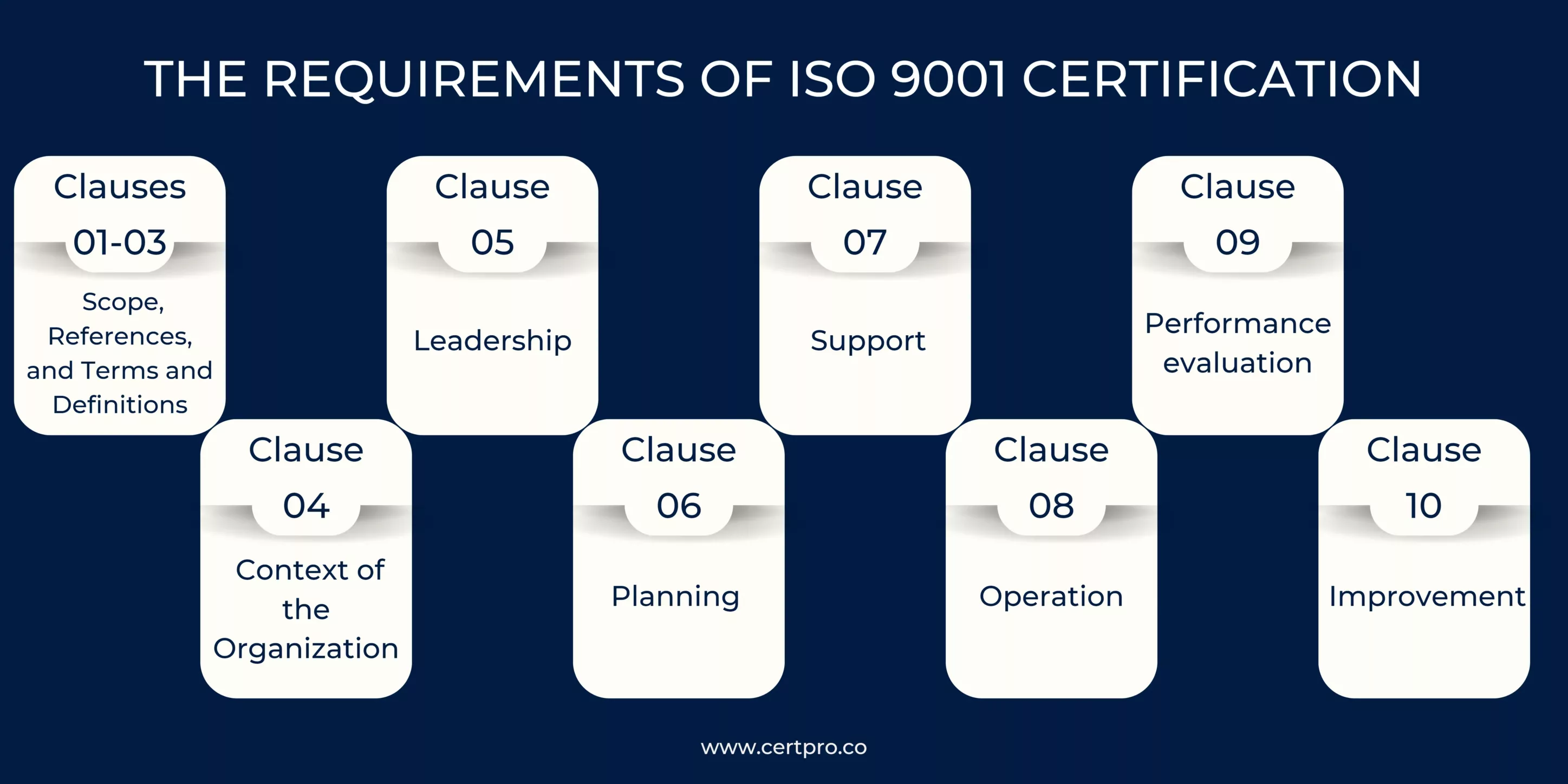
BENEFITS OF ISO 9001 CERTIFICATION
Obtaining ISO 9001 certification offers numerous benefits to organizations. Some of the key advantages include:
- Enhanced Customer Satisfaction: ISO 9001 focuses on meeting customer requirements and improving satisfaction, leading to increased customer loyalty and positive feedback.
- Improved Quality Processes: Implementing ISO 9001 helps organizations establish effective quality management systems, leading to better process efficiency, reduced errors, and improved overall quality.
- Increased Credibility and Reputation: ISO 9001 certification demonstrates a commitment to quality and customer focus, enhancing an organization’s reputation and credibility in the marketplace.
- Competitive Advantage: ISO 9001 certification provides a competitive edge by showcasing the organization’s dedication to quality, attracting potential customers and business partners.
- Better Decision-Making: The systematic approach of ISO 9001 enables organizations to collect and analyze data, facilitating informed decision-making and continuous improvement.
- Streamlined Operations: ISO 9001 promotes streamlined processes, improved resource management, successful risk-based thinking, and increased operational efficiency.
- Compliance and Risk Management: ISO 9001 certification ensures compliance with applicable regulations and standards, reducing risks and enhancing the organization’s ability to address potential issues.
- Employee Engagement and Empowerment: ISO 9001 encourages employee involvement, engagement, and empowerment, fostering a positive work culture and improved teamwork.
- Access to New Markets: ISO 9001 certification is recognized globally, providing access to new markets and business opportunities.
- Continuous Improvement: ISO 9001 promotes a culture of continual improvement, helping organizations identify areas for enhancement, innovate, and stay ahead of competitors.
ISO 9001 certification offers a range of benefits that contribute to organizational growth, customer satisfaction, and operational excellence.
ELIGIBILITY FOR ISO 9001 CERTIFICATION
ISO 9001 certification is exclusively available to organizations and companies, not individuals. The organizations that undergo the certification process demonstrate their adherence to the ISO 9001 quality management standard. However, organizations can pursue certification as an ISO 9001 Certified Lead Auditor, which qualifies them to audit other companies for ISO 9001 compliance. The size of the organization seeking certification is irrelevant, as ISO 9001 applies to businesses of all scales, ranging from sole proprietorships to large enterprises with thousands of employees. It is not limited to specific industries and applies to public and private entities.
The certification signifies that an organization has implemented and maintains a robust quality management system (QMS) that adheres to the requirements of ISO 9001 standards. It demonstrates the organization’s commitment to meeting customer needs, continual improvement, and enhancing overall performance. Organizations in a variety of industries—including manufacturing, services, healthcare, education, and more—seek ISO 9001 certification.
Overall, ISO 9001 certification is accessible to any organization that is dedicated to establishing and maintaining a quality-focused management system, regardless of its size, industry, or location.
THE COST OF ISO 9001 CERTIFICATION
The cost of ISO 9001 certification varies depending on several factors, such as the size and complexity of the organization, the scope of this, the number of locations to be certified, and the chosen certification body or registrar. Generally, the cost includes expenses related to initial assessments, documentation review, on-site audits, certification issuance, and surveillance audits.
Smaller organizations with simpler processes may have lower certification costs compared to larger organizations with multiple locations and complex operations. Additionally, the fees charged by certification bodies can differ based on their reputation, expertise, and additional services provided.
At cost evaluation, organizations consider the long-term benefits of ISO 9001 certification, such as improved quality management, enhanced customer satisfaction, and increased market competitiveness. The investment in certification can yield significant returns by demonstrating a commitment to quality and attracting potential customers who prioritize certified suppliers or service providers.
ISO 9001 CERTIFICATION CHALLENGES AND SOLUTIONS
CHALLENGES IN ISO 9001 CERTIFICATION:
- Lack of compelling case for ISO certification.
- Resistance to change and misconceptions about ISO.
- Inadequate team support or management sponsorship.
- Poor project management or change management.
- Unrealistic expectations.
- Additional expenses and resources are perceived to be required to implement and maintain ISO.
SOLUTIONS IN ISO 9001 CERTIFICATION:
- Emphasize the benefits and competitive advantages of ISO certification.
- Address misconceptions and fears through effective communication and education.
- Secure strong team support and management sponsorship.
- Plan and budget effectively to minimize perceived costs.
- Implement robust project and change management practices.
- Educate stakeholders on the ISO process and manage expectations appropriately.
ISO 9001 CERTIFICATION: VALIDITY AND RECERTIFICATION
Organizations typically hold a valid ISO 9001 certification for three years. Upon certification, they gain the right to display the ISO 9001 certification mark and communicate their adherence to the standard. However, the certification body’s periodic surveillance audits are necessary to maintain certification validity after the initial three-year period. These audits verify that the organization’s quality management system consistently fulfills ISO 9001 requirements. Upon completion of the three-year cycle, organizations must undergo a recertification audit to extend their ISO 9001 certification for another three-year term.
CERTPRO ASSISTANCE IN ISO 9001 CERTIFICATION
CertPro can assist your business in obtaining ISO 9001 certification through its comprehensive auditing, consulting, and certification services. With a team of experienced auditors and consultants, CertPro guides you through the certification process. They apply industry best practices and stay updated with the latest developments in compliance. CertPro conducts thorough assessments, identifies areas for improvement, and assists in implementing effective quality management systems. They provide expert guidance, documentation support, and training to align your business processes with ISO 9001 requirements. CertPro’s goal is to help your business achieve ISO 9001 certification, demonstrating your commitment to quality management and enhancing your reputation in the market.
FAQ’s
WHAT IS A QUALITY MANAGEMENT SYSTEM OR QMS?
A Quality Management System (QMS) is a set of policies, processes, and procedures implemented by an organization to ensure that its products or services consistently meet customer requirements and quality standards.
HOW LONG DOES IT TAKE TO GET ISO 9001 CERTIFICATION?
The time required to obtain ISO 9001 certification varies depending on the organization’s size, complexity, readiness, and resources allocated. On average, the process can take several months to a year or more, including implementation, documentation, internal audits, and the certification audit itself.
WHO ISSUES ISO 9001 CERTIFICATION?
Accredited registrars or certification bodies (CBs) are responsible for issuing ISO 9001 certification. They conduct audits and assessments to evaluate an organization’s compliance with the ISO 9001 standard before granting certification.
IS ISO 9001 CERTIFICATION MANDATORY?
No, ISO 9001 certification is not mandatory. It is a voluntary standard that organizations choose to pursue to demonstrate their commitment to quality management and meet customer expectations. However, in certain industries or when participating in specific contracts, ISO 9001 certification may be required or preferred by customers or regulatory bodies.
HOW DO I SELECT A CERTIFICATION BODY?
When choosing a certification body, consider factors such as accreditation, industry expertise, reputation, cost, and geographical coverage. Verify their accreditation status, review client testimonials, and assess their ability to meet specific certification needs.
HOW DOES THE NIST CYBERSECURITY FRAMEWORK FUNCTION, AND WHY IS IT IMPORTANT?
Emerging cyber threats make cybersecurity an essential consideration for organizations handling and managing data. In this regard, the NIST cybersecurity framework applies to improving your cybersecurity program. It is a set of guidelines that helps improve your...
UNDERSTANDING ISO 42001: A GUIDE FOR RESPONSIBLE AI MANAGEMENT SYSTEMS
The invention of artificial intelligence (AI) has changed the operational processes of many industries. However, the rapid growth of technology increases ethical, security, and privacy-related concerns. Therefore, the International Organization for Standardization...
EUROPEAN UNION’S ARTIFICIAL INTELLIGENCE ACT: HOW THIS GROUNDBREAKING LAW AFFECTS YOUR BUSINESS
Nowadays, Artificial Intelligence (AI) is transforming our lives exceptionally well. AI is now streamlining healthcare services, providing virtual assistance, and fulfilling queries. Technologies have boons and curses. Similarly, AI creates many concerns about...


